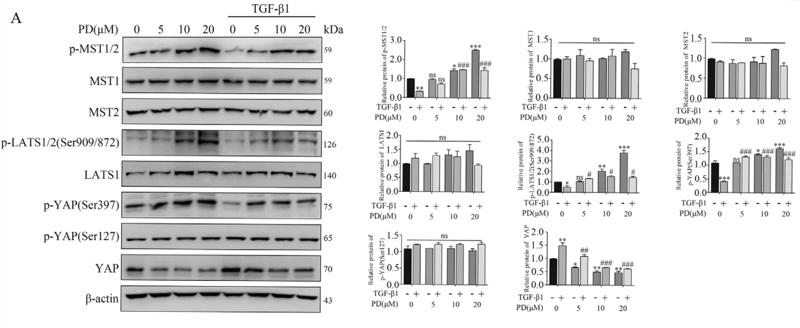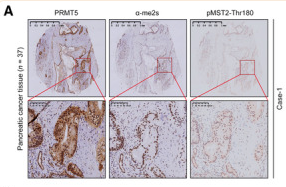| 产品: | 磷酸化 MST1(Thr183)/MST2(Thr180) 抗体 |
| 货号: | AF2367 |
| 描述: | Rabbit polyclonal antibody to Phospho-MST1(Thr183)/MST2(Thr180) |
| 应用: | WB IHC IF/ICC |
| 文献验证: | WB, IHC |
| 反应: | Human, Mouse, Rat |
| 预测: | Pig, Zebrafish, Bovine, Horse, Sheep, Rabbit, Dog, Chicken, Xenopus |
| 分子量: | 59kDa; 56kD(Calculated). |
| 蛋白号: | Q13043 | Q13188 |
| RRID: | AB_2845381 |
产品描述
*The optimal dilutions should be determined by the end user.
*Tips:
WB: 适用于变性蛋白样本的免疫印迹检测. IHC: 适用于组织样本的石蜡(IHC-p)或冰冻(IHC-f)切片样本的免疫组化/荧光检测. IF/ICC: 适用于细胞样本的荧光检测. ELISA(peptide): 适用于抗原肽的ELISA检测.
引用格式: Affinity Biosciences Cat# AF2367, RRID:AB_2845381.
展开/折叠
Kinase responsive to stress; Krs2; Mammalian STE20 like protein kinase 1; Mammalian STE20-like protein kinase 1; Mammalian sterile 20 like 1; MST-1; MST1; Serine/threonine kinase 4; Serine/threonine protein kinase Krs 2; Serine/threonine-protein kinase 4; Serine/threonine-protein kinase Krs-2; STE20 like kinase MST1; STE20-like kinase MST1; STK4; STK4_HUMAN; TIIAC; YSK3; 0610042I06Rik; EC 2.7.11.1; FLJ90748; KB 1458E12.1; Kinase responsive to stress 1; KRS1; Mammalian STE20 like protein kinase 2; Mammalian STE20-like protein kinase 2; Mammalian sterile 20-like 2; Mess1; MST; MST-2; MST2; Mst3; Serine/threonine kinase 3 (STE20 homolog, yeast); Serine/threonine kinase 3 (Ste20, yeast homolog); Serine/threonine kinase 3; Serine/threonine protein kinase 3; Serine/threonine protein kinase Krs1; Serine/threonine-protein kinase 3; Serine/threonine-protein kinase Krs-1; STE20 like kinase MST2; STE20-like kinase MST2; Stk3; STK3_HUMAN; wu:fc19e11; zgc:55383;
抗原和靶标
A synthesized peptide derived from human MST1 around the phosphorylation site of Thr183.
Expressed in prostate cancer and levels increase from the normal to the malignant state (at protein level). Ubiquitously expressed.
Q13188 STK3_HUMAN:Expressed at high levels in adult kidney, skeletal and placenta tissues and at very low levels in adult heart, lung and brain tissues.
- Q13043 STK4_HUMAN:
- Protein BLAST With
- NCBI/
- ExPASy/
- Uniprot
METVQLRNPPRRQLKKLDEDSLTKQPEEVFDVLEKLGEGSYGSVYKAIHKETGQIVAIKQVPVESDLQEIIKEISIMQQCDSPHVVKYYGSYFKNTDLWIVMEYCGAGSVSDIIRLRNKTLTEDEIATILQSTLKGLEYLHFMRKIHRDIKAGNILLNTEGHAKLADFGVAGQLTDTMAKRNTVIGTPFWMAPEVIQEIGYNCVADIWSLGITAIEMAEGKPPYADIHPMRAIFMIPTNPPPTFRKPELWSDNFTDFVKQCLVKSPEQRATATQLLQHPFVRSAKGVSILRDLINEAMDVKLKRQESQQREVDQDDEENSEEDEMDSGTMVRAVGDEMGTVRVASTMTDGANTMIEHDDTLPSQLGTMVINAEDEEEEGTMKRRDETMQPAKPSFLEYFEQKEKENQINSFGKSVPGPLKNSSDWKIPQDGDYEFLKSWTVEDLQKRLLALDPMMEQEIEEIRQKYQSKRQPILDAIEAKKRRQQNF
- Q13188 STK3_HUMAN:
- Protein BLAST With
- NCBI/
- ExPASy/
- Uniprot
MEQPPAPKSKLKKLSEDSLTKQPEEVFDVLEKLGEGSYGSVFKAIHKESGQVVAIKQVPVESDLQEIIKEISIMQQCDSPYVVKYYGSYFKNTDLWIVMEYCGAGSVSDIIRLRNKTLIEDEIATILKSTLKGLEYLHFMRKIHRDIKAGNILLNTEGHAKLADFGVAGQLTDTMAKRNTVIGTPFWMAPEVIQEIGYNCVADIWSLGITSIEMAEGKPPYADIHPMRAIFMIPTNPPPTFRKPELWSDDFTDFVKKCLVKNPEQRATATQLLQHPFIKNAKPVSILRDLITEAMEIKAKRHEEQQRELEEEEENSDEDELDSHTMVKTSVESVGTMRATSTMSEGAQTMIEHNSTMLESDLGTMVINSEDEEEEDGTMKRNATSPQVQRPSFMDYFDKQDFKNKSHENCNQNMHEPFPMSKNVFPDNWKVPQDGDFDFLKNLSLEELQMRLKALDPMMEREIEELRQRYTAKRQPILDAMDAKKRRQQNF
种属预测
score>80的预测可信度较高,可尝试用于WB检测。*预测模型主要基于免疫原序列比对,结果仅作参考,不作为质保凭据。
High(score>80) Medium(80>score>50) Low(score<50) No confidence
研究背景
Stress-activated, pro-apoptotic kinase which, following caspase-cleavage, enters the nucleus and induces chromatin condensation followed by internucleosomal DNA fragmentation. Key component of the Hippo signaling pathway which plays a pivotal role in organ size control and tumor suppression by restricting proliferation and promoting apoptosis. The core of this pathway is composed of a kinase cascade wherein STK3/MST2 and STK4/MST1, in complex with its regulatory protein SAV1, phosphorylates and activates LATS1/2 in complex with its regulatory protein MOB1, which in turn phosphorylates and inactivates YAP1 oncoprotein and WWTR1/TAZ. Phosphorylation of YAP1 by LATS2 inhibits its translocation into the nucleus to regulate cellular genes important for cell proliferation, cell death, and cell migration. STK3/MST2 and STK4/MST1 are required to repress proliferation of mature hepatocytes, to prevent activation of facultative adult liver stem cells (oval cells), and to inhibit tumor formation (By similarity). Phosphorylates 'Ser-14' of histone H2B (H2BS14ph) during apoptosis. Phosphorylates FOXO3 upon oxidative stress, which results in its nuclear translocation and cell death initiation. Phosphorylates MOBKL1A, MOBKL1B and RASSF2. Phosphorylates TNNI3 (cardiac Tn-I) and alters its binding affinity to TNNC1 (cardiac Tn-C) and TNNT2 (cardiac Tn-T). Phosphorylates FOXO1 on 'Ser-212' and regulates its activation and stimulates transcription of PMAIP1 in a FOXO1-dependent manner. Phosphorylates SIRT1 and inhibits SIRT1-mediated p53/TP53 deacetylation, thereby promoting p53/TP53 dependent transcription and apoptosis upon DNA damage. Acts as an inhibitor of PKB/AKT1. Phosphorylates AR on 'Ser-650' and suppresses its activity by intersecting with PKB/AKT1 signaling and antagonizing formation of AR-chromatin complexes.
Autophosphorylated on serine and threonine residues. Phosphorylation at Thr-387 by PKB/AKT1, leads to inhibition of its: kinase activity, nuclear translocation and autophosphorylation at Thr-183. It also diminishes its cleavage by caspases and its ability to phosphorylate FOXO3.
Proteolytically cleaved by caspase-3 during apoptosis at Asp-326 and Asp-349 resulting in a 37 kDa or a 39 kDa subunit respectively. The 39 kDa subunit is further cleaved into the 37 kDa form. Proteolytic cleavage results in kinase activation and nuclear translocation of the truncated form (MST1/N). It is less likely that cleavage at Asp-349 is a prerequisite for activation as this site is not conserved in the murine ortholog.
Cytoplasm. Nucleus.
Note: The caspase-cleaved form cycles between the nucleus and cytoplasm.
Expressed in prostate cancer and levels increase from the normal to the malignant state (at protein level). Ubiquitously expressed.
Belongs to the protein kinase superfamily. STE Ser/Thr protein kinase family. STE20 subfamily.
Stress-activated, pro-apoptotic kinase which, following caspase-cleavage, enters the nucleus and induces chromatin condensation followed by internucleosomal DNA fragmentation. Key component of the Hippo signaling pathway which plays a pivotal role in organ size control and tumor suppression by restricting proliferation and promoting apoptosis. The core of this pathway is composed of a kinase cascade wherein STK3/MST2 and STK4/MST1, in complex with its regulatory protein SAV1, phosphorylates and activates LATS1/2 in complex with its regulatory protein MOB1, which in turn phosphorylates and inactivates YAP1 oncoprotein and WWTR1/TAZ. Phosphorylation of YAP1 by LATS2 inhibits its translocation into the nucleus to regulate cellular genes important for cell proliferation, cell death, and cell migration. STK3/MST2 and STK4/MST1 are required to repress proliferation of mature hepatocytes, to prevent activation of facultative adult liver stem cells (oval cells), and to inhibit tumor formation. Phosphorylates NKX2-1 (By similarity). Phosphorylates NEK2 and plays a role in centrosome disjunction by regulating the localization of NEK2 to centrosome, and its ability to phosphorylate CROCC and CEP250. In conjunction with SAV1, activates the transcriptional activity of ESR1 through the modulation of its phosphorylation. Positively regulates RAF1 activation via suppression of the inhibitory phosphorylation of RAF1 on 'Ser-259'. Phosphorylates MOBKL1A and RASSF2. Phosphorylates MOBKL1B on 'Thr-74'. Acts cooperatively with MOBKL1B to activate STK38.
Phosphorylation at Thr-117 and Thr-384 by PKB/AKT1, leads to inhibition of its: cleavage, kinase activity, autophosphorylation at Thr-180, binding to RASSF1 and nuclear translocation, and increase in its binding to RAF1.
Proteolytically cleaved by caspase-3 during apoptosis. Proteolytic cleavage results in kinase activation and nuclear translocation of the truncated form (MST1/N).
Cytoplasm. Nucleus.
Note: The caspase-cleaved form cycles between nucleus and cytoplasm (By similarity). Phosphorylation at Thr-117 leads to inhibition of nuclear translocation.
Expressed at high levels in adult kidney, skeletal and placenta tissues and at very low levels in adult heart, lung and brain tissues.
Belongs to the protein kinase superfamily. STE Ser/Thr protein kinase family. STE20 subfamily.
研究领域
· Environmental Information Processing > Signal transduction > MAPK signaling pathway. (View pathway)
· Environmental Information Processing > Signal transduction > Ras signaling pathway. (View pathway)
· Environmental Information Processing > Signal transduction > FoxO signaling pathway. (View pathway)
· Environmental Information Processing > Signal transduction > Hippo signaling pathway. (View pathway)
· Environmental Information Processing > Signal transduction > Hippo signaling pathway - multiple species. (View pathway)
· Human Diseases > Cancers: Overview > Pathways in cancer. (View pathway)
· Human Diseases > Cancers: Specific types > Non-small cell lung cancer. (View pathway)
文献引用
Application: WB Species: Mouse Sample: pancreatic cancer
Application: IHC Species: Mouse Sample: pancreatic cancer
Application: WB Species: human Sample: LX-2 cells
Application: WB Species: human Sample: FTC238 cells
限制条款
产品的规格、报价、验证数据请以官网为准,官网链接:www.affbiotech.com | www.affbiotech.cn(简体中文)| www.affbiotech.jp(日本語)产品的数据信息为Affinity所有,未经授权不得收集Affinity官网数据或资料用于商业用途,对抄袭产品数据的行为我们将保留诉诸法律的权利。
产品相关数据会因产品批次、产品检测情况随时调整,如您已订购该产品,请以订购时随货说明书为准,否则请以官网内容为准,官网内容有改动时恕不另行通知。
Affinity保证所销售产品均经过严格质量检测。如您购买的商品在规定时间内出现问题需要售后时,请您在Affinity官方渠道提交售后申请。产品仅供科学研究使用。不用于诊断和治疗。
产品未经授权不得转售。
Affinity Biosciences将不会对在使用我们的产品时可能发生的专利侵权或其他侵权行为负责。Affinity Biosciences, Affinity Biosciences标志和所有其他商标所有权归Affinity Biosciences LTD.





